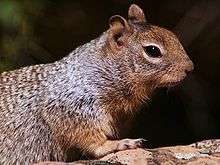Rock squirrel
The rock squirrel (Otospermophilus variegatus) is a species of rodent in the family Sciuridae and is native to Mexico and the southwestern United States, including southern Nevada, Utah, Colorado, Arizona, New Mexico, Western Texas and the panhandle of Oklahoma.[2]
| Rock squirrel | |
|---|---|
 | |
| Scientific classification | |
| Kingdom: | Animalia |
| Phylum: | Chordata |
| Class: | Mammalia |
| Order: | Rodentia |
| Family: | Sciuridae |
| Genus: | Otospermophilus |
| Species: | O. variegatus |
| Binomial name | |
| Otospermophilus variegatus (Erxleben, 1777) | |
| Synonyms | |
|
Spermophilus variegatus | |
Characteristics
Rock squirrels are one of the largest members of the family Sciuridae, with adults measuring up to 21 inches (53 cm) in length.[3] In front and on top, the squirrel's coat is a speckled grayish brown; on the rear and bottom the gray becomes a more mottled brownish-black tone. They have a marked light-colored ring around their eyes and pointed ears that project well above their heads. Rock squirrels have a long bushy tail with white edges.
Life history/behavior
The female rock squirrel has two litters a year, with three to nine young in each litter. The first litter is typically born between April and June, while the second is born between August and September. They are active in the early morning and late afternoons when it is warm – when very hot, they may estivate. They are social, and live in colonies with several females and one dominant male who fights other mature males to protect the group. Subordinate males lurk at the outer boundaries of the group. Rock squirrels dig burrows with their sharp claws and muscular legs. The burrows provide shelter, safety, living space, and food storage. Burrow systems can be complex and lengthy, as they are enlarged over a period of years. Entrances are usually hidden beneath rocks and can be larger than 3 inches in width. In the northern reach of their habitat, rock squirrels hibernate during the colder months of the year. In southern areas, rock squirrels may not hibernate at all.[4]
They can withstand long periods of time without water, some even up to 100 days.[5]
When alarmed, they whistle a short, sharp, oscillating call.
Diet
The rock squirrel is predominantly a herbivore, eating mostly leaves, stems, seeds, invertebrates and small vertebrates. They also eat acorns, pine nuts, fruits of native plants, assorted grasses, mesquite, juniper berries, agaves and cacti. The primary invertebrates include grasshoppers, beetles and earthworms and the vertebrates include young wild turkeys and other fowl.[6] The rock squirrel may eat their own kind, scavenging the remains of squirrels that are already dead. Its diet changes with the seasons, accustoming itself to what is available locally.[7]
The rock squirrel forages for its food on a daily basis, by climbing trees and bushes and finding food on the ground. Rock squirrels collect generous amounts of food items in their cheek pouches, which are quite large. One researcher counted 62 Gambel's oak acorns carried in one squirrel's pouch.[6] These foraging trips are generally short-lived, usually only lasting approximately 12 minutes. Most foraging is done during the morning hours, to avoid the hotter parts of the day. They eat some of the food right away and bring a significant portion back to a lookout point or burrow, where they can safely consume the rest.[8]
Predators
There are a variety of snakes, birds of prey, and other mammals (bobcats, ringtails, gray foxes, raccoons, coyotes, badgers, domestic cats and dogs) that prey upon the rock squirrel. Humans have also been known to eat rocks squirrels, but can also view them as pests, resulting in lethal and non-lethal removal. The rock squirrel displays a variety of anti-predator behaviors. When close to a snake, they make menacing movements and even throw debris at the snake. They often feed, rest and sunbathe in trees, high rocks and stumps. This allows them to watch for predators and to communicate alarm calls to other squirrels. They also emit musky scent from its anal glands when disturbed by predators.[2]
References
- Linzey, A. V.; Timm, R.; Álvarez-Castañeda, S. T.; Castro-Arellano, I. & Lacher, T. (2008). "Spermophilus variegatus". IUCN Red List of Threatened Species. 2008. Retrieved 8 January 2009.CS1 maint: ref=harv (link)
- Langstaff, Lucas. ""Spermophilus variegatus rock squirrel"". nhpbs.org. Retrieved 2019-10-11.
- Helgen, Kristofer M.; Cole, F. Russel; Helgen, Lauren E. & Wilson, Don E (2009). "Generic Revision in the Holarctic Ground Squirrel Genus Spermophilus" (PDF). Journal of Mammalogy. 90 (2): 270–305. doi:10.1644/07-MAMM-A-309.1. Archived from the original (PDF) on 22 October 2011.
- March, p. 2 2.
- Oaks, p. 5.
- Langstaff, Lucas. "Spermophilus variegatus (rock squirrel)". Animal Diversity Web. Retrieved 2019-10-11.
- Rock Squirrel - Spermophilus variegatus Nature Works
- "ADW: Spermophilus variegatus: INFORMATION". Animal Diversity Web.
Sources
- "Rock Squirrel - Spermophilus Variegatus." Rock Squirrel. N.p., n.d. Web. 14 May 2015.
- "Rock Squirrel." S. N.p., n.d. Web. 14 May 2015. animals in the United States and Mexico June 26, 2015
- Oaks, Emily C.; Kirkland, Gordon L.; Schmidt, David F.; Young, Paul J. (1987). Spermophilus Variegatus. Soc.
- Belding's, California
- Marsh, Rex E., Rock Ground Squirrels
- Oaks, Emily C. Mammalian Species
External links


- Smithsonian rock squirrel article
- The American Society of Mammalogists species account
- Arizona-Sonora Desert Museum
